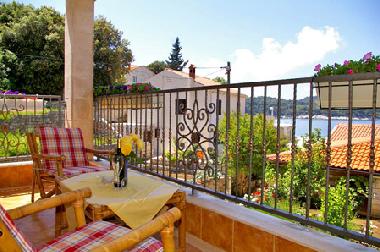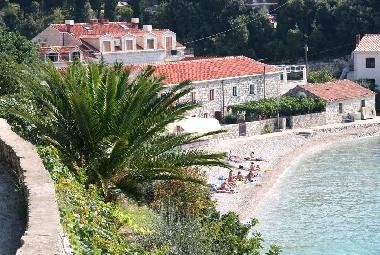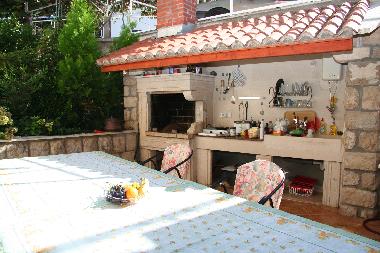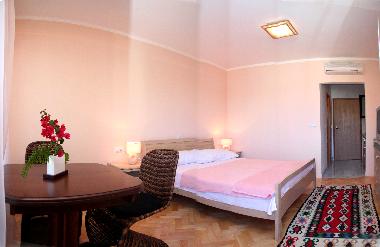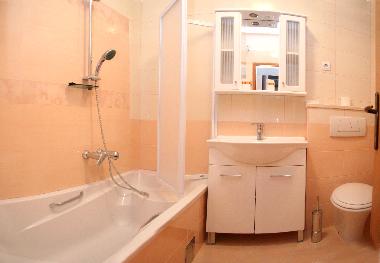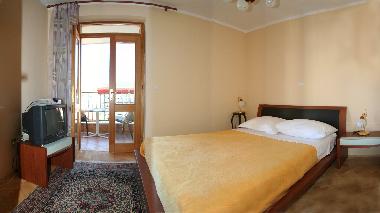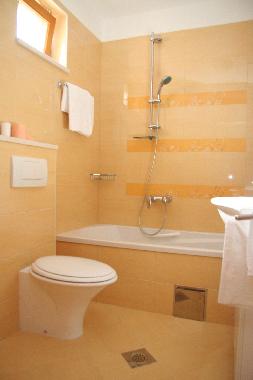








CURRENT OBJECT: VILLA ANA
| Next vacation rental in Dubrovacko-Neretvanska | |
| Next vacation rental in Croatia |
Current region: Europe > Croatia > Dubrovacko-Neretvanska > Dubrovnik | Add to your favorite list Your favoritelist |
Driving to Dubrovnik, you will see a beautiful bay Zaton, where is located place Stikovica with a nu
| More pictures... | ||||||
Rental Price25 Euro per person per nightPrice includes following expenses
Description of objectAt only 10 min from historical Dubrovnik Zaton bay is quiet peaceful oases with pebbles beach. Crystal blue sea, mediteran plants, with a vicinity of Dubrovnik, do that Villa is a perfect place for quiet vacation, for family, or older people. In Stikovica you will find the old Dalmatian way off living.Villa Ana is at only 15m from the beach, and at villa you can find terrace with a shade with summer kitchen and all our guests can use the large terrace, together with the outside grill, where is a perfect place to bee during the hot summer days, or to have a dinner. In the neighborhood you can find two restaurants with Dalmatian and intercontinental food. All apartments are fully equipped with new furniture and decorated with style, with air-condition. Private parking is available in front of the house. We can also arrange transfer airport – harbor- Villa Anna, on your requests. Villa Ana Apartment no. 1 – orange Capacity: 3+1 persons Info: The apartment has 31m2 Is intended for 3-4 persons, and consist of : 1 bed room with double bed, 1 sofa bed, bathroom, mini- kitchen, SAT TV, air-condition, parking, grill + terrace, 15m from the beach Villa Ana Apartment no. 2 - blue Capacity: 2+1 persons Info: The apartment has 31m2 Is intended for 3 persons, and consist of : 1 bed room with double bed, 1 sofa bed, bathroom, mini- kitchen, SAT TV, air-condition, parking, grill + terrace, 15m from the beach Villa Ana Apartment no. 3 -viola Capacity: 2+1 persons Info: The apartment has 22m2 Is intended for 2 +1 persons, and consist of : 1 bed room with double bed, 1 extra bed, bathroom, mini- kitchen, SAT TV, air-condition, parking, grill + terrace, 15m from the beach Villa Ana Apartment no. 4 - rose Capacity: 2 persons Info: The apartment has 22m2 Is intended for 2 persons, and consist of : 1 bed room with double bed, ( baby-bed ), bathroom, mini- kitchen, SAT TV, air-condition, parking, grill + terrace, 15m from the beach Villa Ana Apartment no. 5 - yellow Capacity: 4 persons Info: The apartment has 45m2 Is intended for 4 persons, and consist of : 1 bed room with double bed, bathroom, kitchen, living-room with sofa-bed, balcony, SAT TV, air-condition, parking, grill + terrace, 15m from the beach Villa Ana Apartment no. 6 – Capacity: 2 persons Info: The room has 14m2 Is intended for 2 persons, and consist of : 1 bed room with double bed, bathroom, SAT TV, air-condition, parking, grill + terrace, 15m from the beach Villa Ana Apartment no. 7 - white Capacity: 2+3 persons Info: The apartment has 50m2 at is on ground floor. Is intended for 2 persons with children, and consist of : 1 bed room with double bed, bathroom, kitchen, living-room with sofa-bed, SAT TV, air-condition, parking, grill + terrace, 15m from the beach Location of objectWe organize transfers from airport Dubrovnik, harbors, bus stations... to your destination (to hotel or private accommodation).With huge variety of excursions from our offer, we give you the opportunity to visit a beautiful scenery and cultural and historical places of southern Dalmacia.Town: Croatia, Stikovica, DubrovnikDubrovnikFrom Wikipedia, the free encyclopedia Jump to: navigation, search ' Position of Dubrovnik within Croatia County Dubrovnik–Neretva Area 143.35km²[1] Location 42°39′N, 18°04′E Mayor Dubravka Šuica (HDZ) Population 49,728 Old City of Dubrovnik* UNESCO World Heritage Site State Party Croatia Type Cultural Criteria i, iii, iv Reference 95 Region† Europe and North America Inscription History Inscription 1979 (3rd Session) Extensions 1994 Endangered 1991-1998 * Name as inscribed on World Heritage List. † Region as classified by UNESCO. The walled city of Dubrovnik Stradun, Dubrovnik's main street Republic of Ragusa before 1808For the Dubrovnik meteorite of 1951, see meteorite falls. Dubrovnik (in Italian Ragusa) IPA: [ˈdǔ.bro̞ːʋ.nik]) is a historic city on the Adriatic Sea coast in the extreme south of Croatia, positioned at 42°39′N, 18°04′E at the terminal end of the Isthmus of Dubrovnik. It is one of the most prominent tourist resorts, a seaport and the center of the Dubrovnik–Neretva county. Its population was 43,770 in 1991 and 49,728 in 2001. in 2001 the absolute majority of its citizens declared themselves as Croats with 88.39% (2001 census). Dubrovnik is nicknamed 'Pearl of the Adriatic'. The prosperity of the city of Dubrovnik has always been based on maritime trade. In the Middle Ages, as the Republic of Ragusa, it became the only eastern Adriatic city-state to rival Venice. Supported by its wealth and skilled diplomacy, the city achieved a remarkable level of development, particularly during the 15th and 16th centuries. Ragusa was one of the centers of the development of the Croatian language and literature, home to many notable poets, playwrights, painters, mathematicians, physicists and other scholars. Contents [hide] 1 Name 2 History 2.1 12th to 19th centuries 2.2 1900 onwards 2.3 JNA Aggression 3 Relations among the nobility 4 Dubrovnik Today 5 Climate 6 Miscellaneous 7 Notable people from Dubrovnik 8 Images of Dubrovnik 9 External links 10 Further reading [edit] Name The modern name of the city is derived from the Slavic word 'dubrava' ('forest' in English). In Croatian, the city is known as Dubrovnik and in Dalmatian, Latin, Italian, and formerly in English as Ragusa. The Slavic toponym Dubrovnik, now assigned to the ancient city of Ragusa, comes from the name of a Slavic village tribe, the Dubrons (from dubrava, wood, forest), which was firmly established at the end of the 11th century in the oak forest on the hills, to the north of city of Ragusa. Pressured by hostile tribes from the interior, the Dubrons asked the Republic to grant them refuge inside the walls and they obtained the right of asylum and the residence in a marginal quarter of the city. Among themselves, the refugees named the quarter after their native-born village: Dubrovnik. A name that was never used by the republic of Ragusa in its thousand-year history, that it covered without other languages but Latin (official language of the republic by 1472) in acts, agreements, laws, treaties, relationships, public or private documents. In its 13 century history this never changed, from its establishment until the extinction of Ragusa in 1814 due to annexation by Austria. Even in that period, its secular and authentic name was used. The current name was officially adopted after World War I when the city became part of the new country of Yugoslavia. [edit] History See also Republic of Ragusa. [edit] 12th to 19th centuries Dubrovnik was founded by joining two small settlements: a settlement on a rock named Laus (lat.) on the south of todays city, which provided shelter for the Greek and Latin refugees from the nearby city of Epidamnus today's Cavtat; and Dubrava, a settlement of Slavic at the foot of the forested Srđ hill. The strip of wetland between the two parts of the town, was reclaimed in the 12th century, unifying the city around the newly-made plaza (today Placa or Stradun). The plaza was paved in 1468 and reconstructed after the earthquake of 1667. The city was fortified and two harbours were built on each side of the isthmus. From its establishment in the 7th century, the town was under the protection of the Byzantine Empire. After the Crusades, Ragusa/Dubrovnik came under the sovereignty of Venice (1205–1358), and by the Peace Treaty of Zadar in 1358 it became part of the Hungarian–Croatian Kingdom. Between the 14th century and 1808 Dubrovnik ruled itself as a free state named Respublica Ragusina, the Republic of Ragusa. The Republic of Ragusa reached its peak in the 15th and 16th centuries, when its thalassocracy rivalled that of the Republic of Venice and other Italian maritime republics. The Republic of Ragusa received its own Statutes as early as 1272, statutes which, among other things, codified Roman practice and local customs. The Statutes included prescriptions for town planning and the regulation of quarantine (for hygienic reasons). The Republic was very inventive regarding laws and institutions that were developed very early: - medical service was introduced in 1301 - the first pharmacy (still working) was opened in 1317 - a refuge for old people was opened in 1347 - the first quarantine hospital (Lazarete) was opened in 1377 - slave trading was abolished in 1418 - the orphanage was opened in 1432 - the water supply system (20 kilometers) was constructed in 1436 The city was ruled by aristocracy that formed two city Councils (Vijeće). They maintained a strict system of social classes, but they also abolished slave trade early in the 15th century and valued liberty highly. The city successfully balanced its sovereignty between the interests of Venice and the Ottoman Empire for centuries. The economic strength of Ragusa Republic was due to its developed land and especially seafaring trade. With the help of skilled diplomacy, Ragusa's merchants traveled lands freely, and on the sea the city had a huge fleet of merchant ships (argosy) that traveled all over the world. From these travels they founded some settlements, from India to America, and brought parts of their culture and vegetation home with them. One of the keys to success was not conquering but trading and sailing under a white flag with the word freedom (Latin LIBERTAS) prominently featured on it. That flag was adopted when slave trading was abolished in 1418, long before other countries even thought about it. Many Conversos (Marranos)- Jews from Spain and Portugal were attracted to the city. In May, 1544, a ship landed there filled exclusively with Portuguese refugees, as Balthasar de Faria reported to King John. During this time there worked in the city one of the most famous cannon and bell founders of his time: Ivan Rabljanin (Magister Johannes Baptista Arbensis de la Tolle). The Republic gradually declined after a crisis of Mediterranean shipping — and especially a catastrophic earthquake in 1667 that killed over 5000 citizens, including the Rector, leveling most of the public buildings - ruined the well-being of the Republic. In 1699 it was forced to sell two patches of its territory to the Ottomans in order to protect itself from the advancing Venetian forces. Its final demise was caused not by Venice, but by Napoleon's forces, which conquered first the Venetian territories and then the Republic in 1806. In 1806 the city surrendered to French forces, as that was the only way to cut a month's long siege by the Russian-Montenegrin fleets (during which 3000 cannon balls fell on the city). At first Napoleon demanded only free passage for his troops, promising not to occupy the territory and stressing that the French were friends of the Ragusans. Later, however, French forces blockaded the harbours, forcing the government to give in and let French troops enter the city. On this day, all flags and coats of arms above the city walls were painted black as a sign of grief. In 1808, Marshal Marmont abolished the republic and integrated its territory into the Illyrian provinces. When the Habsburg Empire gained these provinces after the 1815 Congress of Vienna, the new imperial authorities installed a bureaucratic administration, which retained the essential framework of the Venetian / Italian-speaking system, but also introduced a series of modifications intended to centralize, albeit slowly, the bureaucratic, tax, religious, educational, and trade structures. Unfortunately for the local residents, these centralization strategies, which were intended to stimulate the economy, largely failed. And once the personal, political and economic trauma of the Napoleonic Wars had been overcome, new movements began to form in the region, calling for a political reorganization of the Adriatic along national lines. The combination of these two forces--a flawed Habsburg administrative system and new national movements claiming ethnicity as the founding block towards a community--created a particularly perplexing problem; for Dalmatia was a province ruled by the German-speaking, centralizing Habsburg monarchy, with Italian-speaking elites that dominated a general population consisting of a Croatian, Catholic Slav majority and a strong Serb Orthodox minority. Though always an unreliable estimate, census takers in 1846 counted 16,000 Italians, 320,000 Croatians and 80,000 Serb Orthodox. In 1815 the former Ragusan Government, i.e. its noble assembly, met for the last time in the ljetnikovac in Mokosica. Once again heavy efforts were undertaken to reestablish the Republic however this time it was all in vain. After the fall of the Republic most of the aristocracy died out and emigrated overseas. Others were recognized by the Austrian Empire. In 1848, the Croatian Assembly (Sabor) published the People's Requests in which they requested among other things the abolition of serfdom and the unification of Dalmatia with the rest of Croatian lands (primarily with Austro-Hungarian Kingdom of Croatia). The Dubrovnik Municipality was the most outspoken of all the Dalmatian communes in its support for unification with Croatia. A letter was sent to Zagreb with pledges to work for this idea. In 1849, Dubrovnik continued to lead the Dalmatian cities in the struggle for unification. A large-scale campaign was launched in the local paper L'Avvenire (The Future) based on a clearly formulated programme: the federal system for the Habsburg territories, the inclusion of Dalmatia into united Croatia and the Slavic brotherhood. In the same year, the first issue of the Dubrovnik almanac appeared, Flower of the National Literature (Dubrovnik, cvijet narodnog knjizevstva), in which Petar Preradovic published his noted poem 'To Dubrovnik'. This and other literary and journalistic texts, which continued to be published, contributed to the awakening of the national consciousness reflected in efforts to introduce the Croatian language into schools and offices, and to promote Croatian books. The Emperor Franz Joseph brought the so-called Imposed Constitution which prohibited the unification of Dalmatia and Croatia and also any further political activity with this end in view. The political struggle of Dubrovnik to be united with Croatia, which was intense throughout 1848 and 1849, did not succeed at that time. In 1861 was the meeting of the first Dalmatian Assembly, with representatives from Ragusa. Representatives of Cattaro (now Kotor) came to join the struggle for unification with Croatia. The citizens of Ragusa gave them a festive welcome, flying Croatian flags from the ramparts, and exhibiting the slogan: Ragusa with Cattaro. The people of Cattaro elected a delegation to go to Vienna; Ragusa nominated Niko Pucic. Niko Pucic went to Vienna to demand not only the unification of Dalmatia with Croatia, but also the unification of all Croatian territories under one common Assembly. In 1883 occurred the death of politician Niko Pucic (born 1820). He was a member of the Croatian Assembly and champion of the unification of Dalmatia (particularly Dubrovnik) with Croatia. He was the editor of the review Dubrovnik and founder of the review Slovinac. In the same year died Ivan August Kaznacic (born 1817), publicist and promoter of the Illyrian/Croatian cause. He edited the review Zora dalmatinska (Dalmatian Dawn) and founded the review L'Avvenire. In 1893, the minister of the city, the Baron Francesco Ghetaldi-Gondola, opened the monument for Ivan Gundulic in Piazza Gundulic (Gondola). Rooftops in Dubrovnik's Old City, a UNESCO World Heritage Site. [edit] 1900 onwards Although colloquially known to its residents as Dubrovnik for centuries, the city's official name was Ragusa and was changed to Dubrovnik only in 1918 with the fall of Austria-Hungary and the incorporation of the area into the Kingdom of Serbs, Croats, and Slovenes, later the Kingdom of Yugoslavia. At the very beginning of World War II, Dubrovnik was first part of the Independent State of Croatia. From April 1941 until September 1943, Dubrovnik was occupied by the Italian army and after that by the Germans. In October 1944, the Partisans liberated Dubrovnik from the Germans and it became part of the second Yugoslavia in 1945 which was made up of 6 different republics. [edit] JNA Aggression Main article Siege of Dubrovnik Dubrovnik Shelling (black dots) 1991 to 1992.Dubrovnik was part of the Socialist Republic of Croatia. In 1990 the republics of the Socialist Federal Republic of Yugoslavia reached their independence. The Socialist Republic of Croatia was renamed into Republic of Croatia. Despite the demilitarization of the old town early in the 1970s in an attempt to prevent it from ever becoming a casualty of war, following Croatia's independence in 1991, the Serbian-Montenegro remains of the Yugoslav People's Army (JNA) attacked the city. At October 1, 1991 Dubrovnik was attacked by the JNA with a siege of Dubrovnik lasted for seven months. The heaviest artillery attack happened on December 6 with 19 people killed and 60 wounded. Total casualties in the conflict according to the Croatian Red Cross were 114 killed civilians, among them the celebrated poet Milan Milisić. In May 1992 the Croatian Army liberated Dubrovnik and its surroundings, but the danger of JNA sudden attacks lasted for another three years. Following the end of the war, the damage caused by shelling of the Old Town was repaired adhering to UNESCO guidelines. Repairs were performed in the original style. As of 2005, most damage has been repaired. The inflicted damage can be seen on a chart near the city gate showing all artillery hits during the siege. ICTY indictments were issued for the JNA generals and officers involved in the bombing. Final report of the United Nations Commission of Experts says: 'Due to the ideal observation capacity that the JNA enjoyed through its command of the high ground, the air, and the sea, it seems clear that (at best) the JNA was indifferent to the civilian casualties it caused or (at worst) it deliberately and systematically targeted civilians and civilian objects throughout this period.' Video of the attack on Dubrovnik [edit] Relations among the nobility This article or section needs copy editing for grammar, style, cohesion, tone and/or spelling. You can assist by editing it now. A how-to guide is available, as is general documentation. This article has been tagged since May 2007.It has been suggested that this article or section be merged with Republic of Ragusa#id:Relation between Nobility. (Discuss) Is peculiar that even survived when the classes were divided by internal disputes. When Marmont arrived at Dubrovnik in 1808, it was whereupon the nobility was divided in two blocks, the “Salamanquinos” and the “Sorboneses”. These names alluded to to certain controversy arisen from the wars between Charles V of Spain and Francis I of France, happened hardly two hundred fifty years back. It was that in the 1667 earthquake a great part of the noble class was annihilated, being necessary to give back his force to him with the inclusion of certain plebians. To these the salamanquinos, those in favor of Spanish absolutism, did not treat them like equal; but the inclined sorboneses, added to the frenchs, and to a certain liberalism, accepted them without reserves. Another factor that could take part in this conduct is that the sorboneses had been very decreased by the earthquake and they did not want to lose cash. In any case, both sides had he himself status and they seated together in the Council, but they did not maintain relations social and not even they were greeted by the street; an inconvenient marriage between members of both groups was of so serious consequences as if it occurred between members of different classes. This social split was also reflected in the inferior layers: “The plebians, as well, were divided in the brotherhoods of St. Antony and St. Lazaro, who was so unfriendly in their relations as salamnaquinos and sorboneses”. He was in the essence of the Republic, that always had to be defended of neighboring empires --“first Hungary, soon Venice, later Turkey”-- and that was structured for a reduced number of people, around the 33 original noble families of century XV. [edit] Dubrovnik Today Dubrovnik bridge and the Port of GruzToday Dubrovnik is a tranquil touristic and cultural center hosting many musical, art and theater events year round. The annual Dubrovnik Summer Festival is a cultural event when keys of the city are given to artists who entertain Dubrovnik's population and their guests for entire month with live plays, concerts, and games. Ivan Gundulić, a 17th century Croatian writer, predicted the downfall of the great Turkish Empire in his great poem Osman. He wrote these immortal verses that are performed on every opening of the world famous Dubrovnik Summer Festival: O, beautiful liberty, dear and sweet, Thou heavenly gift where riches all meet, Actual source of our glory of these hours, The sole adornment of this of ours, All silver, all gold, and our lives so dear, Cannot recompense thy beauty so clear. With these verses Dubrovnik major invites actors and poems to enter through main gates inside city stone walls. As young actor Goran Visnjic played Hamlet at the Dubrovnik Summer Festival. He was noticed and approved by the public at the very start of his career. The Dubrovnik Summer Festival has been awarded its first Gold International Trophy for Quality (2007) by the Editorial Office in collaboration with the Trade Leaders Club. February 3 is the feast of Sveti Vlaho (Saint Blaise), who is the city's patron saint. Every year the city of Dubrovnik celebrates the holiday with Mass, parades, and festivities that last for several days. [2] Dubrovnik and his surroundings with beautiful islands have lot to offer in touristic activities for younger generations also. Climbing on steep hills, hiking through the Mediterranean nature, paddling and swimming in clean transparent sea is what is also part of fun in Dubrovnik. New historical discovers say that the usual misconception of Dubrovnik coming to be as joining of Laus island and Slav settlement of Dubrovnik is disputed by the fact that there was no island of Laus, only a peninsula, and it seems that there was a port on its location dating back to ancient history (thought to be the lost port of Heraclea!)[citation needed] [edit] Climate The climate along the Dubrovnik Region is a typical Mediterranean one, with mild, rainy winters and hot and dry summers. The air temperatures can slightly vary, depending on the area or region. Summer temperatures in July rise till 34°C in the northern part, while in the southern part they usually rise to 38°C. During winter the coldest temperatures are recorded in the northern Adriatic with temperatures dropping sometimes below zero, while the southern regions of the Adriatic coast generally remain above zero. Air temperature average annual 16.4°C (61.5°F) average of coldest period (January) 9°C (48.2°F) average of warmest period (August) 24.9°C (76.8°F) Sea temperature average May - September 17.9°C - 23.8°C (64.2°F - 74.8°F) Salinity approximately 38 ‰ (parts per thousand) Precipitation average annual 1,020.8 mm average annual rain days 109.2 Sunshine average annual 2629 l average daily hours: 7.2 h [edit] Miscellaneous The patron saint of the city is Sveti Vlaho (Saint Blaise), whose statues are seen around the city. He has an importance similar to that of St. Mark the Evangelist to Venice. The old city is a UNESCO World Heritage Site. Many Conversos (Marranos) were attracted to Dubrovnik, formerly a considerable seaport. In May, 1544, a ship landed there filled exclusively with Portuguese refugees, as Balthasar de Faria reported to King John. Inhabitants of Dubrovnik often proudly quote the Irish playwright and man of letters, George Bernard Shaw, who visited the city in 1929: 'If you want to see heaven on earth, come to Dubrovnik.' Dubrovnik hosted the tenth and final Congrès Internationaux d'Architecture Moderne in 1956. The oldest arboretum in the world, Arboretum Trsteno, dating from before 1492, is near Dubrovnik. The oldest European pharmacy, dating from 1317 is located at Little Brothers church in Dubrovnik. The Republic of Dubrovnik was the first state to recognize the United States of America as a sovereign state. The English word argosy is derived from ragusye, which means 'vessel of Ragusa', the old name of Dubrovnik. 30 minutes by car from the old city is the Dubrovnik Highlands (which is in Bosnia and Herzegovina). This area is commonly known for its crystal clear water, pine forests, rough mountain terrain, huge carp fish, winter sports, and hot dry summers. In the bay of Dubrovnik is the 72-hectare wooded island of Lokrum, where according to legend, Richard the Lionheart was cast ashore after being shipwrecked in 1192. The island includes a fortress, botanical garden, monastery and naturist beach. The Australian rock band The Dubrovniks (1987–95) owed its name to the origin of the father of one of the members. In the feature film Rosemary's Baby, Roman Castevet, the leader of the witch coven, is falsely said to be in Dubrovnik, leading Rosemary to exclaim on his presence, 'You're in Dubrovnik, I can't hear you.' Find out more about Dubrovnik Arrival and distancesArrival day: negotiableDistance to next airport: Dubrovnik 30 Km Sport facilities nearbyDiving, Fishing, Sailing, Water ski,Theme of holidays
Total sleeping facilities and distributionTotal number of sleeping facilities: 15
BathroomsNo. of bathrooms: 10
External facilities of object
Internal facilities of object
Machines and equipment
Kitchen facilities
Services
Other
CateringCatering: Self catered (extra) |
| ||||||||||||||||||||||||||||||||||||||||||||||||||||||||||||||||||||||||||||||||||||||||||||||||||||||||||||||||||||||||||||||||||||||||||||||||||||||||||||||||||||||||||||||||||||||||||||||||||||||||||||||||||||||||||||||||||||||||||||||||||||||||||||||||||||||||||||||||||||||||||||||||||||||||||||||||||||||||||||||||||||||||||||||||||||||||||||||||||||||||||||||||||||||||||||||||||||||||||||||||||||||||||||||||||||||||||||||||||||||||||||||||||||||||||||||||||||||||||||||||||||||||||||||||||||||||||||||||||||||||||||||||||||||||||||||||||||||||||||||||||||||||||||||||||||||||||||||||||||||||||||||||||||||||||||||||||||||||||||||||||||||||||||||||||||||||||||||||||||||||||||||||||||||||||||||||||||||||||||||||||||||||||||||||||||||||||||||||||||||||||||||||||||||||||||||||||||||||||||||||||||||||||||||||||||||||||||||||||||||||||||||||||||||||||||||||||||||||||||||||||||||||||||||||||||||||||||||||||||||||||||||||||||||||||||||||||||||||||||||||||||||||||||||||||||||||||||||||||||||
| |||||||||||||||||||||||||||||||||||||||||||||||||||||||||||||||||||||||||||||||||||||||||||||||||||||||||||||||||||||||||||||||||||||||||||||||||||||||||||||||||||||||||||||||||||||||||||||||||||||||||||||||||||||||||||||||||||||||||||||||||||||||||||||||||||||||||||||||||||||||||||||||||||||||||||||||||||||||||||||||||||||||||||||||||||||||||||||||||||||||||||||||||||||||||||||||||||||||||||||||||||||||||||||||||||||||||||||||||||||||||||||||||||||||||||||||||||||||||||||||||||||||||||||||||||||||||||||||||||||||||||||||||||||||||||||||||||||||||||||||||||||||||||||||||||||||||||||||||||||||||||||||||||||||||||||||||||||||||||||||||||||||||||||||||||||||||||||||||||||||||||||||||||||||||||||||||||||||||||||||||||||||||||||||||||||||||||||||||||||||||||||||||||||||||||||||||||||||||||||||||||||||||||||||||||||||||||||||||||||||||||||||||||||||||||||||||||||||||||||||||||||||||||||||||||||||||||||||||||||||||||||||||||||||||||||||||||||||||||||||||||||||||||||||||||||||||||||||||||||||

